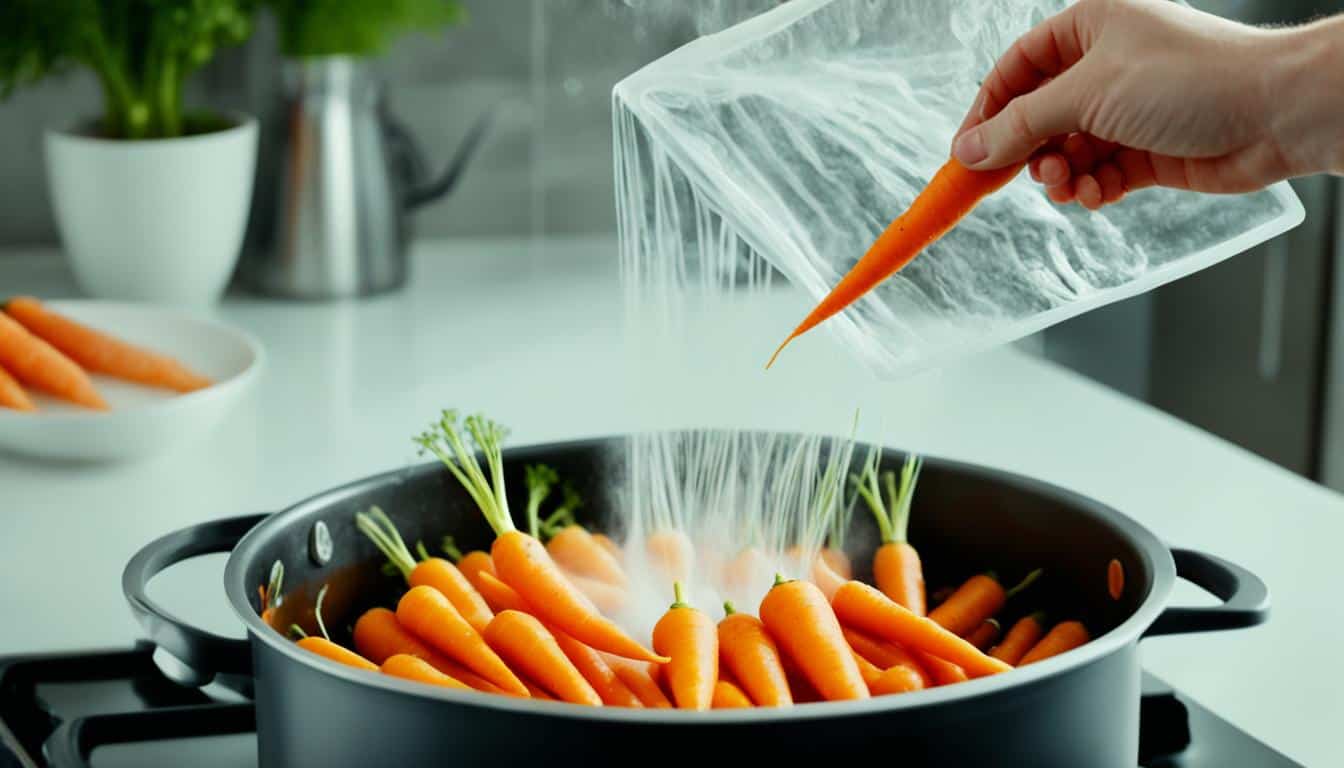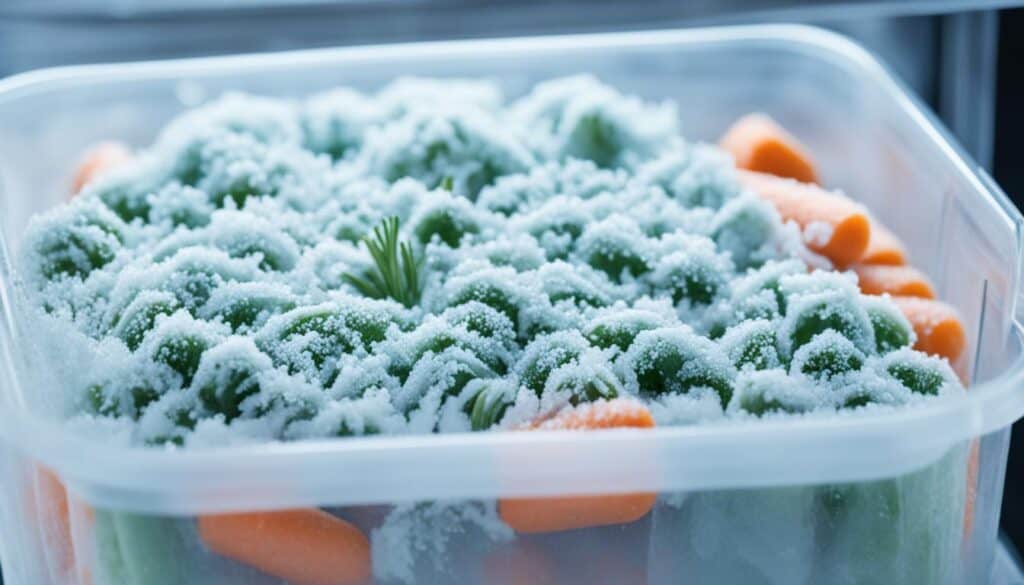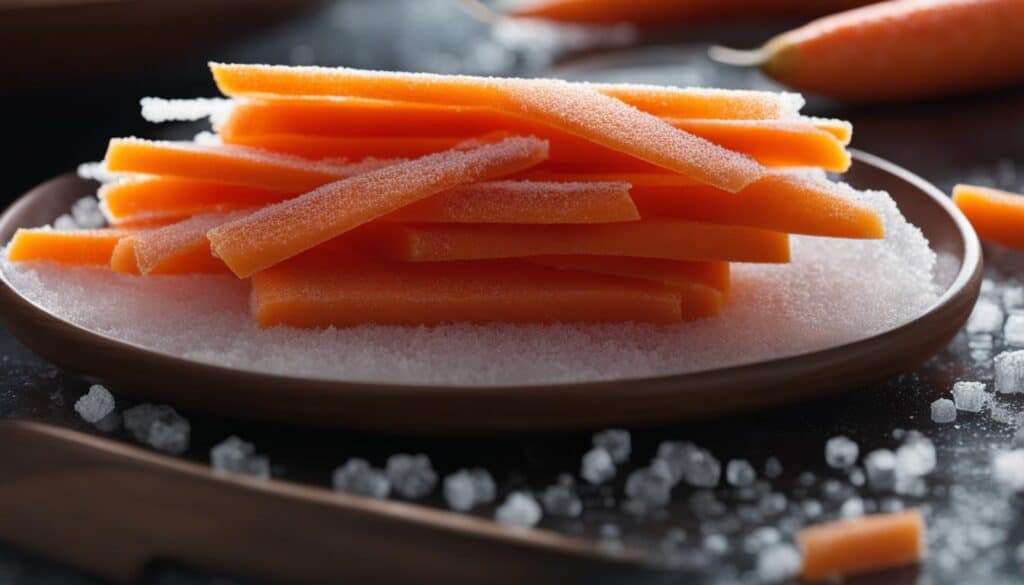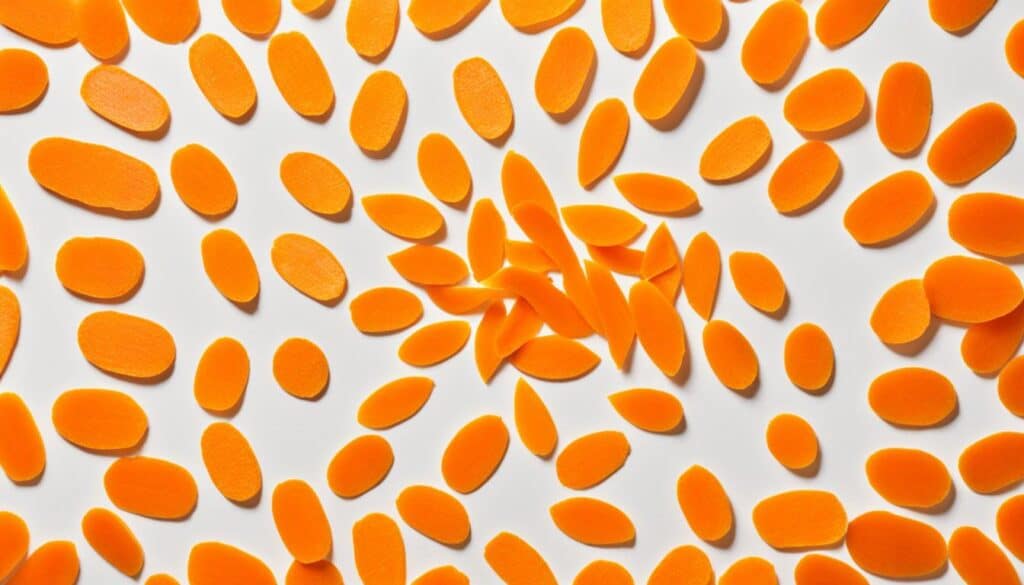Did you know that over 700 million pounds of carrots are wasted each year in the United States alone? That’s a staggering amount of food that could have been enjoyed if only it had been properly preserved. That’s why I want to share with you my best tips for freezing carrots.
Key Takeaways:
- Freezing carrots is a great way to prevent food waste and ensure you always have fresh veggies on hand.
- Proper equipment, such as a vegetable peeler and freezer bags, makes the freezing process easier and more efficient.
- Blanching carrots before freezing helps preserve their color, texture, and nutrition.
- Flash freezing allows for individual piece freezing and prevents the carrots from sticking together.
- Frozen carrots can last up to 12 months when stored properly in airtight containers.
Why Freeze Carrots?
Freezing carrots offers numerous benefits and advantages, making it a practical and convenient method for preserving these nutritious vegetables. Let’s explore the reasons why freezing carrots is a smart choice:
- Preserving Nutritional Value: Freezing carrots helps retain their essential nutrients, vitamins, and minerals. The process of freezing halts the degradation of these valuable components, ensuring that you can enjoy the same nutritional benefits when you use them.
- Extending Flavor and Texture: By freezing carrots, you can lock in their natural flavors and textures. This means that when you thaw and cook the carrots, they will still have the same crispness and taste as when they were fresh.
- Reducing Food Waste: Freezing carrots allows you to store surplus or excess carrots, preventing them from going to waste. Instead of letting them spoil, you can freeze the carrots and use them at a later time, reducing food waste and saving money.
- Convenience and Accessibility: Having frozen carrots on hand provides convenience in meal preparation. Whether you need to add some extra veggies to a stir-fry, soup, or casserole, having frozen carrots readily available in your freezer makes it quick and easy to incorporate them into your favorite recipes.
Preserving carrots by freezing is an effective way to ensure you always have this versatile vegetable within reach. Now that we’ve explored the benefits of freezing carrots, let’s dive into the equipment needed for the freezing process.
Benefits of Freezing Carrots
| Benefits | Description |
|---|---|
| Preserves Nutritional Value | Retains essential nutrients, vitamins, and minerals. |
| Extends Flavor and Texture | Locks in natural flavors and maintains crispness. |
| Reduces Food Waste | Prevents surplus carrots from spoiling. |
| Provides Convenience and Accessibility | Readily available for quick and easy use in recipes. |
Equipment Needed for Freezing Carrots
When it comes to freezing carrots, having the right tools can make the process much easier and more efficient. Here are the essential pieces of equipment you’ll need:
1. Vegetable Peeler
A good quality vegetable peeler will help you quickly remove the outer skin of the carrots, making them ready for slicing or blanching.
2. Cutting Board and Knife
A sturdy cutting board and a sharp knife are essential for safely and efficiently chopping your carrots into slices or coins.
3. Pot of Boiling Water
You’ll need a large pot of boiling water for blanching the carrots. Make sure the pot is big enough to hold the quantity of carrots you wish to freeze.
4. Slotted Spoon
A slotted spoon will come in handy for removing the blanched carrots from the boiling water and transferring them to the ice water bath.
5. Mixing Bowl with Ice Water
Prepare a bowl of ice water to immediately cool down the blanched carrots and stop the cooking process. This will help preserve their color, texture, and nutrients.
6. Baking Sheet and Parchment or Wax Paper
Use a baking sheet lined with parchment or wax paper to spread out the blanched carrots in a single layer for flash freezing. This prevents them from sticking together.
7. Freezer Bags or Containers
To store the frozen carrots, you’ll need airtight freezer bags or containers. Label them with the date of freezing for easier tracking.
8. Freezer or Deep Freeze
Lastly, you’ll need access to a freezer or deep freeze with enough space to accommodate the containers or bags of frozen carrots.
Having the right equipment will streamline the process of freezing carrots and ensure that they retain their quality during storage.
Now that you have all the necessary tools, it’s time to move on to the next step: preparing the carrots for freezing.
Preparing Carrots for Freezing
Before freezing carrots, it’s important to properly prepare them to ensure optimal results. Follow these steps to clean and trim your carrots for freezing:
Cleaning Carrots
To clean your carrots, start by rinsing them under cold running water. Gently scrub the exterior with a vegetable brush to remove any dirt or debris. If your carrots have greens attached, trim them off, leaving a small portion of the stem intact.
Trimming Carrots
Next, trim off the ends of the carrots to remove any blemishes or tough portions. Use a sharp knife to make clean cuts, ensuring that the carrots are of uniform size for consistent freezing and cooking.
If desired, you can also peel the carrots before freezing. While peeling is not necessary, it can help preserve the most nutrients and ensure a smoother texture in cooked dishes.
Once cleaned and trimmed, you can choose to slice the carrots into ½-inch coins or leave them whole for blanching. Sliced carrots are convenient for portioning and using in various recipes, while whole carrots are ideal for preserving their natural shape and texture.
Properly preparing your carrots for freezing will help them freeze evenly and maintain their quality during storage.
Blanching Carrots for Freezing
Blanching is a crucial step in preserving the freshness and quality of carrots when freezing them. Not only does it help retain their vibrant color, but it also helps maintain their texture and nutrition. Blanching is a simple process that involves briefly cooking the carrots before freezing them.
To blanch carrots for freezing, follow these steps:
- Step 1: Start by thoroughly cleaning and trimming the carrots. Peel them if desired to remove any dirt or blemishes.
- Step 2: Cut the carrots into desired shapes, such as slices or coins.
- Step 3: Bring a pot of water to a rolling boil. The pot should be large enough to hold the carrots comfortably without overcrowding.
- Step 4: Carefully add the carrots to the boiling water and let them cook for about 2-5 minutes, depending on their size and desired consistency.
- Step 5: While the carrots are blanching, prepare a bowl of ice water. This will be used to rapidly cool down the carrots and halt the cooking process.
- Step 6: Using a slotted spoon, transfer the blanched carrots from the boiling water and immediately immerse them in the ice water bath. Let them sit for the same amount of time they were blanched.
- Step 7: Once cooled, drain the carrots thoroughly and pat them dry with a clean kitchen towel or paper towel.
Blanching carrots for freezing serves multiple purposes. Firstly, it stops enzyme actions that can lead to deterioration of color, texture, and taste. Secondly, blanching cleanses the surface of the carrots, removing any dirt or bacteria that may be present. This helps ensure better storage conditions and prevents the carrots from spoiling quickly.
Image: Blanching Carrots for Freezing
By blanching carrots before freezing, you can enjoy the benefits of having fresh-tasting carrots even months after they have been harvested. The blanching process is relatively quick and easy, but it makes a significant difference in the overall quality of the frozen carrots.
Flash Freezing Carrots
Flash freezing is a quick and efficient method for preserving the freshness of carrots. This technique involves freezing blanched carrot slices or coins individually, preventing them from sticking together and allowing for easy portioning. Here are the steps to flash freeze carrots:
- Step 1: After blanching the carrots, prepare a lined baking sheet. This will prevent the carrots from sticking to the surface.
- Step 2: Spread the blanched carrot slices or coins in a single layer on the baking sheet. Ensure that they are not touching each other.
- Step 3: Place the baking sheet with the carrots in the freezer and allow them to freeze for around an hour or two, until they are solid.
- Step 4: Once the carrots are frozen, remove the baking sheet from the freezer.
- Step 5: Carefully transfer the individually frozen carrots into freezer bags or containers. Label them with the date for easy tracking.
- Step 6: Return the carrots to the freezer for long-term storage.
By flash freezing carrots, you can conveniently preserve their quality and enjoy the benefits of having individually frozen pieces for various recipes. Now that you know how to flash freeze carrots, let’s move on to the next section to learn more about storing frozen carrots.
| Advantages of Flash Freezing Carrots | Disadvantages of Flash Freezing Carrots |
|---|---|
| – Prevents carrots from sticking together | – Requires sufficient freezer space for flat freezing |
| – Allows for easy portioning | – Requires additional preparation time for blanching |
| – Maintains individual texture and quality | – May need to thaw multiple pieces for specific recipes |
| – Provides flexibility in using desired amount of carrots | – Involves an extra step in the freezing process |
Storing Frozen Carrots
Proper storage is essential to maintain the quality and flavor of your frozen carrots. Here are some tips to help you store them effectively.
- Use airtight freezer bags or containers: To prevent freezer burn and maintain freshness, it is important to store frozen carrots in airtight packaging. This will protect them from moisture and odors in the freezer.
- Seal and label: Ensure that the bags or containers are tightly sealed to create a barrier against air and moisture. Additionally, label them with the date of freezing for easy tracking.
- Optimal freezer storage: Store the frozen carrots in the coldest part of your freezer, preferably at or below 0°F (-18°C). This will help maintain their texture and flavor over time.
By following these storage guidelines, you can extend the shelf life of your frozen carrots and enjoy their freshness for months to come.
Recommended Freezer Storage Times:
Here is a general guideline for the length of time frozen carrots can be stored:
| Type of Carrots | Blanched and Flash-Frozen | Raw, Unblanched |
|---|---|---|
| Whole Carrots | Up to 12 months | Up to 2 months |
| Sliced/Chopped Carrots | Up to 12 months | Up to 2 months |
Remember, these storage times are estimates and the quality of the carrots may vary depending on factors such as the initial freshness and storage conditions.
“Properly sealed and stored, blanched and flash-frozen carrots can last up to 12 months in the freezer.”
By keeping these storage recommendations in mind, you can enjoy the convenience and freshness of your frozen carrots throughout the year.
Using Frozen Carrots
When it comes to adding convenience and versatility to your cooking, frozen carrots are a pantry staple. They can be used in a wide range of cooked dishes, adding vibrant color, nutrients, and a touch of sweetness. Whether you’re whipping up a hearty soup, a comforting stew, or a flavorful casserole, frozen carrots are a fantastic ingredient to have on hand.
Unlike other frozen vegetables that may need to be thawed before cooking, frozen carrots can be added directly from the freezer to your recipes. This means no extra prep time or adjustments to cooking times. Simply grab a handful of frozen carrots and toss them into your dish for a burst of flavor and nutrition.
One of the greatest benefits of using frozen carrots is their ability to retain their texture and shape during the cooking process. They offer a satisfying crunch and a vibrant color even after being frozen, making them a delightful addition to any meal.
Let’s explore some delicious recipes that make the most of frozen carrots:
Hearty Vegetable Soup
Create a comforting bowl of warmth with a hearty vegetable soup packed with frozen carrots. Combine the frozen carrots with other frozen vegetables, such as peas and corn, and simmer them in a flavorful broth. Add some herbs and spices to enhance the taste, and enjoy a wholesome and nutritious soup.
Chicken and Vegetable Stir-Fry
For a quick and nutritious stir-fry, grab a bag of frozen carrots and toss them into a sizzling pan with your favorite vegetables and some lean chicken slices. The frozen carrots will add a burst of color and freshness to your stir-fry, giving it a satisfying crunch.
Root Vegetable Medley
Bring together a variety of root vegetables, including frozen carrots, for a vibrant and nutritious side dish. Roast the vegetables in the oven until they are tender and caramelized. The frozen carrots will maintain their shape and add a hint of sweetness to the medley.
With these delicious recipes, you can easily incorporate frozen carrots into your cooking routine and enjoy the convenience of having nutritious vegetables at your fingertips. Whether you’re looking to add color, texture, or flavor to your dishes, frozen carrots are a versatile ingredient that can elevate any recipe.
Thawing and Reheating Frozen Carrots
Once you have successfully frozen your carrots, it’s important to know how to thaw and reheat them properly to maintain their quality and flavor. Here are the best practices for thawing and reheating frozen carrots:
Thawing Frozen Carrots
To thaw frozen carrots, transfer them from the freezer to the refrigerator. Allow them to thaw overnight, or for at least 8 hours. Thawing carrots slowly in the refrigerator helps prevent the loss of moisture and preserves their texture.
Reheating Frozen Carrots
Once thawed, there are several ways you can reheat your frozen carrots:
- Stovetop: Place the thawed carrots in a saucepan and add a small amount of water or broth. Heat over medium heat until heated through, stirring occasionally.
- Microwave: Transfer the thawed carrots to a microwave-safe dish. Cover with a microwave-safe lid or plastic wrap, leaving a small vent for steam to escape. Heat on high for 1-2 minutes, or until heated through. Stir halfway through to promote even heating.
- Directly in Hot Dishes: If you’re using the thawed carrots in a recipe that requires cooking, you can add them directly from the thawed state. They will heat up during the cooking process.
Note: Reheating time may vary depending on the quantity and size of the carrots. It’s important to check for the desired temperature before consuming.
Usage Tips:
“Thawed and reheated carrots should be used within a few days to maintain their quality and prevent any risk of foodborne illnesses. Be sure to store leftovers properly.”
By following these methods for thawing and reheating frozen carrots, you can ensure that they retain their delicious taste and nutritional value. Whether you’re enjoying them as a side dish or incorporating them into your favorite recipes, properly thawed and reheated frozen carrots are a convenient and versatile addition to your meals.
Other Ways to Preserve Carrots
While freezing is a popular method for preserving carrots, there are alternative options available that can suit your personal preferences and resources. Canning and dehydrating are two effective techniques to extend the shelf life of carrots and provide versatility in your culinary endeavors.
Canning Carrots
Canning carrots involves preserving them in jars, allowing you to enjoy their flavor and nutritional benefits throughout the year. The process typically includes washing, peeling, and boiling the carrots until they reach the desired tenderness. Once properly cooked, the carrots are packed into sterilized jars with a liquid such as water or vegetable broth, and then processed in a pressure canner or boiling water bath. The result is tender, preserved carrots that can be conveniently stored on your pantry shelf.
Below is a table outlining the basic steps involved in canning carrots:
| Steps for Canning Carrots |
|---|
| 1. Wash, peel, and trim the carrots. |
| 2. Cut the carrots into desired sizes. |
| 3. Blanch the carrots by boiling them for a few minutes. |
| 4. Pack the blanched carrots into sterilized jars. |
| 5. Add boiling liquid (e.g., water or vegetable broth) to the jars, leaving appropriate headspace. |
| 6. Remove air bubbles by tapping the jars gently and adjust the liquid level if necessary. |
| 7. Seal the jars with lids and process in a pressure canner or boiling water bath. |
| 8. Allow the jars to cool and check for proper seals before storing in a cool, dark place. |
Dehydrating Carrots
Dehydrating carrots involves removing the moisture from the vegetable, which helps prevent spoilage and preserves their flavor. Dehydrated carrots are lightweight and take up minimal storage space, making them convenient for long-term preservation. This technique can be achieved using a food dehydrator, an oven, or even the sun. Once dehydrated, the carrots can be stored in airtight containers.
Below is a table outlining the basic steps involved in dehydrating carrots:
| Steps for Dehydrating Carrots |
|---|
| 1. Wash, peel, and trim the carrots. |
| 2. Slice or grate the carrots into thin and uniform pieces. |
| 3. Blanch the carrots by boiling them briefly (optional). |
| 4. Arrange the carrots in a single layer on dehydrator trays or baking sheets. |
| 5. Dehydrate the carrots at the recommended temperature (around 125°F to 135°F) until they are dry and crisp. |
| 6. Allow the dehydrated carrots to cool completely before storing in airtight containers. |
By exploring these alternative methods for preserving carrots, you can enjoy the delicious taste and nutritional benefits of carrots even when they are out of season. Canning provides a pantry staple, while dehydrating offers a lightweight and space-saving option for adding flavor and nutrients to your meals.
Next, I’ll conclude by summarizing the various techniques and offering some final tips for maximizing the preservation of carrots.
Conclusion
Freezing carrots is a practical and efficient method for preserving the freshness and flavor of these versatile vegetables. By following the recommended techniques for blanching, flash freezing, and proper storage, you can enjoy the benefits of having frozen carrots on hand for months.
Blanching the carrots before freezing helps to preserve their color, texture, and nutritional value. This process stops enzyme actions and cleanses the surface of the carrots, resulting in better storage conditions.
Once blanched, the carrots can be flash frozen by laying them out on a lined baking sheet until solid. This method prevents the carrots from sticking together and allows for individual piece freezing. Afterward, the carrots can be transferred to airtight freezer bags or containers for long-term storage.
When using frozen carrots, they can be added directly to cooked dishes such as soups, stews, and casseroles without the need for thawing. However, it is not recommended to use frozen carrots in cold dishes as they may become soggy. Thawing the carrots in the refrigerator overnight before use is recommended for best results.
By incorporating frozen carrots into your cooking repertoire, you can reduce food waste and always have a supply of this nutritious vegetable readily available. Whether you’re preparing a hearty stew or a comforting casserole, frozen carrots offer convenience and versatility. So give freezing carrots a try and enjoy the benefits of a well-stocked freezer and a variety of delicious meals all year round!










Leave a Reply